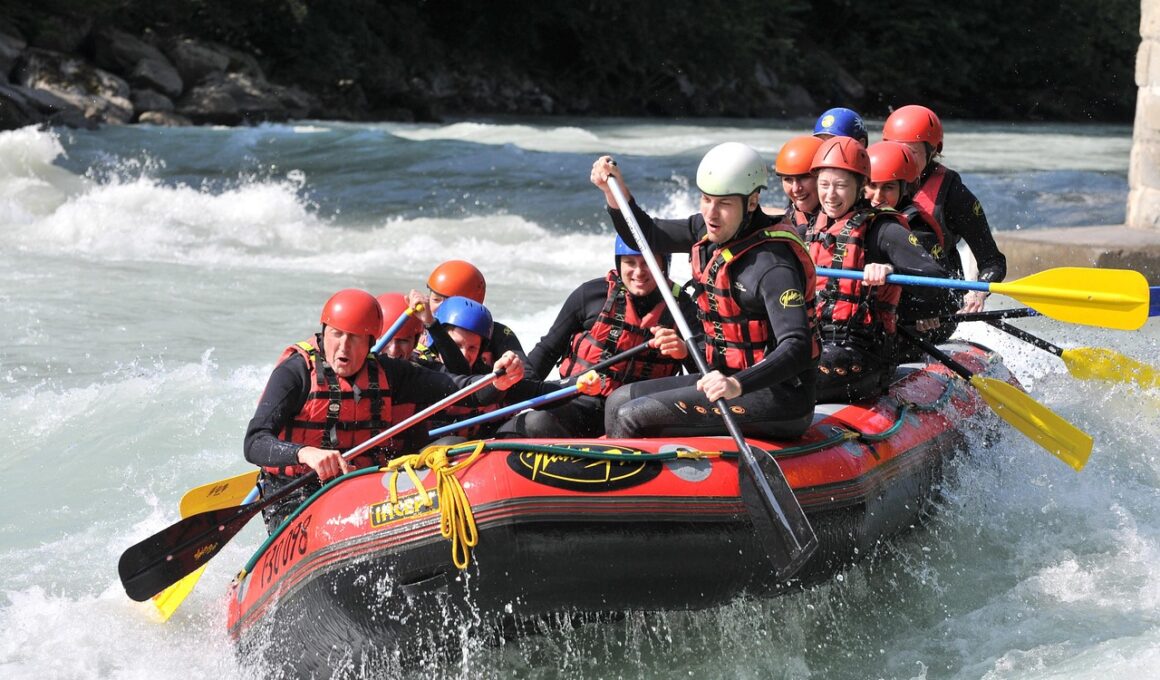Hydrospeeding vs. Other Water Sports: What’s the Difference?
Hydrospeeding is an exhilarating water sport in which participants ride on a small inflatable board while navigating through rivers or rapids. This adventure activity involves lying down on the board and using fins to propel oneself through the water. It offers a unique blend of surfing and rafting, making it an exciting option for thrill-seekers. Hydrospeeding generally takes place in white-water environments, where rapid currents can challenge even seasoned adventurers. The adrenaline rush stems from zipping along powerful waterways at high speeds, all while maintaining balance and navigating obstacles. Unlike traditional rafting or kayaking, which utilizes larger vessels for movement, hydrospeeding relies heavily on the individual’s skills. Participants must be competent swimmers and familiar with the river’s dynamics to ensure safety and control. The specific equipment includes a bodyboard, fins, and safety gear such as helmets and wetsuits. Hydrospeeding can be practiced solo or in groups, which makes it versatile for various skill levels. Ultimately, it stands out among water sports because it combines speed, skill, and a strong connection with the river environment.
When comparing hydrospeeding to other popular water sports, several distinct differences emerge. Kayaking, for instance, involves using a specially designed kayak to navigate through water, and while it offers paddling techniques, it doesn’t quite provide the same thrill as hydrospeeding. Kayakers remain seated and use paddles to steer, leading to a different experience altogether. On the other hand, paddleboarding offers stability and a more relaxed environment compared to the fast-paced nature of hydrospeeding. Participants stand atop a large board and paddle across calm waters, often enjoying picturesque views. Surfing, meanwhile, focuses on riding ocean waves while standing on a surfboard, which contrasts sharply with the close, low-profile position required in hydrospeeding. Additionally, surfing necessitates specific ocean conditions that not all adventure seekers can access. Furthermore, each sport attracts different communities and levels of expertise. Hydrospeeding appeals to those craving extreme water action and a solid adrenaline kick, whereas other sports like kayaking and paddleboarding attract individuals looking for leisure or scenic experiences on the water.
The Skills Required for Different Water Sports
Participating in hydrospeeding requires a specific skill set that is both thrilling and complex. Participants must be aware of river currents, obstacles, and the techniques to balance on a small board. Moreover, hydrospeeding demands superior swimming abilities since one can easily fall into the water. Conversely, kayaking necessitates proficient paddling skills and stability in a vessel, offering a more controlled environment. Kayakers often take their time to navigate waters, focusing on technique over speed. On the other hand, surfing requires not only sharp reflexes but also strong wave-reading abilities, making it a strategic sport. Surfers have to predict wave patterns and understand how to catch and ride waves effectively. Paddleboarding focuses more on balance and core strength, allowing participants to enjoy a different experience related to stability. Thus, while all water sports involve physical activity, the skills required and the learning curve can vary dramatically. Choosing the right water sport ultimately aligns with one’s personal interests, physical attributes, and desired thrill levels while engaging on the water.
Safety measures in hydrospeeding also differ from those in other water sports, given the nature of the activity. Hydrospeeding participants are equipped with safety gear such as helmets, life jackets, and wetsuits to provide protection against impacts while navigating through tumultuous waters. This is crucial because the fast-moving currents can lead to unforeseen circumstances. Comparatively, kayaking emphasizes the use of life vests and, in some instances, helmets depending on the river’s intensity. Surfing also prioritizes safety by requiring surf leashes to prevent board loss and impacts, though conditions vary widely. On the other hand, paddleboarding is generally deemed safer since it occurs on calmer waters, minimizing risks of rapid currents. Safety education is essential across all sports, yet hydrospeeding demands a rigorous understanding of how to manage expectations in changing water conditions. Each sport’s safety considerations serve to enhance the experience and minimize dangers associated with water activities. Consequently, knowing the risks involved and how to protect oneself can optimize fun and enjoyment in each water sport.
Cultural Significance and Community Impact
The cultural significance of hydrospeeding and other water sports varies dramatically. Hydrospeeding has gained a cult-like following in regions known for intense river currents, drawing individuals keen on adventure. Local communities often celebrate this sport with competitions that foster camaraderie and push boundaries. In contrast, kayaking holds a rich history intertwined with indigenous cultures, where traditional boats are a testament to heritage, offering a unique approach toward water navigation. Likewise, surfing, particularly in coastal areas, holds deep cultural connections, blending art, music, and lifestyle into a vibrant community. Paddleboarding, a newer phenomenon, is rapidly gaining traction, especially in wellness-focused communities, emphasizing health and leisure. Collectively, these water sports can promote tourism, environmental awareness, and the protection of aquatic ecosystems through community engagement. For those interested in cultural exchange, participating in local events can provide invaluable insights into the water sports landscape. While hydrospeeding may appear niche, its growth reflects the diverse interests of adventurers and enthusiasts who appreciate the thrill of interaction with nature.
Understanding the environmental impact of various water sports is essential for preservation efforts. Hydrospeeding, given its intense engagement with natural rivers, necessitates responsible practices to safeguard these ecosystems. This sport can draw attention to the need for clean water and pollution-free environments, encouraging eco-conscious behavior among participants. Kayaking, too, promotes environmental awareness, as paddlers often encounter nature directly, becoming advocates for conservation through their experiences. Similarly, surfing has a long-standing relationship with ocean health; many surfers participate in beach clean-ups to preserve their playing fields. Paddleboarding also resides on the peaceful side, often focusing on riparian health and understanding aquatic ecosystems. Promoting sustainability across all water sports fosters a sense of shared responsibility, ensuring that nature remains accessible for future generations. Environmental stewardship within these sports builds community solidarity, motivating individuals to champion clean waterways and better habitats. Collaborative efforts, such as clean-up events and educational programs, bridge the gap between excitement and conservation, leading to a better understanding of our planet’s beauty and the need for its protection.
The Future of Hydrospeeding and Water Sports
As we look ahead, the future of hydrospeeding and water sports hinges on technology, environmental changes, and global interests. Advancements in equipment such as more durable and lightweight materials can enhance safety and performance. Furthermore, integrating technology into water sports through apps or equipment can help enthusiasts track their skills and environments more effectively. Global interest in eco-tourism may also bolster the popularity of hydrospeeding, focusing on remote locations where pristine rivers await exploration. Seasonal and adventure travel will likely shape the way enthusiasts choose their water sports. With the growing awareness of climate change, it is imperative that those involved in hydrospeeding and others advocate for sustainable practices. Future generations will need to prioritize conservation to protect aquatic environments crucial for these activities. Opportunities beyond traditional means, such as hydrospeeding competitions and community events, can inspire new participants and showcase the spirit of collaborative adventure. Ultimately, the future of hydrospeeding and water sports will depend on the resilience and creativity of its community to adapt to ever-changing landscapes.
In conclusion, hydrospeeding offers a thrilling experience distinct from traditional water sports. Its unique demands include skills in balance and swift navigation through river currents. While kayaking, surfing, and paddleboarding provide varied experiences, hydrospeeding draws those eager for excitement and challenges. All these activities bring people together through adventure and community events. Understanding the role of safety, culture, and environmental impact can enrich one’s outdoor endeavors. As technology evolves, so might the methods and practices surrounding these sports, pushing their boundaries while encouraging responsible participation. Embracing innovation can lead to a future where more individuals can engage with the exhilarating world of hydrospeeding and water sports. Collaboration among enthusiasts and advocates will ensure that these pursuits continue fostering connections with nature while enjoying the thrill of water. Each water sport gives unique insights into environmental interaction and emphasizes the importance of preservation. The camaraderie experienced through shared challenges draws people closer, enhancing the appeal of water sports. Therefore, whether new or seasoned, participants contribute to the vibrant tapestry of the water sports community.


